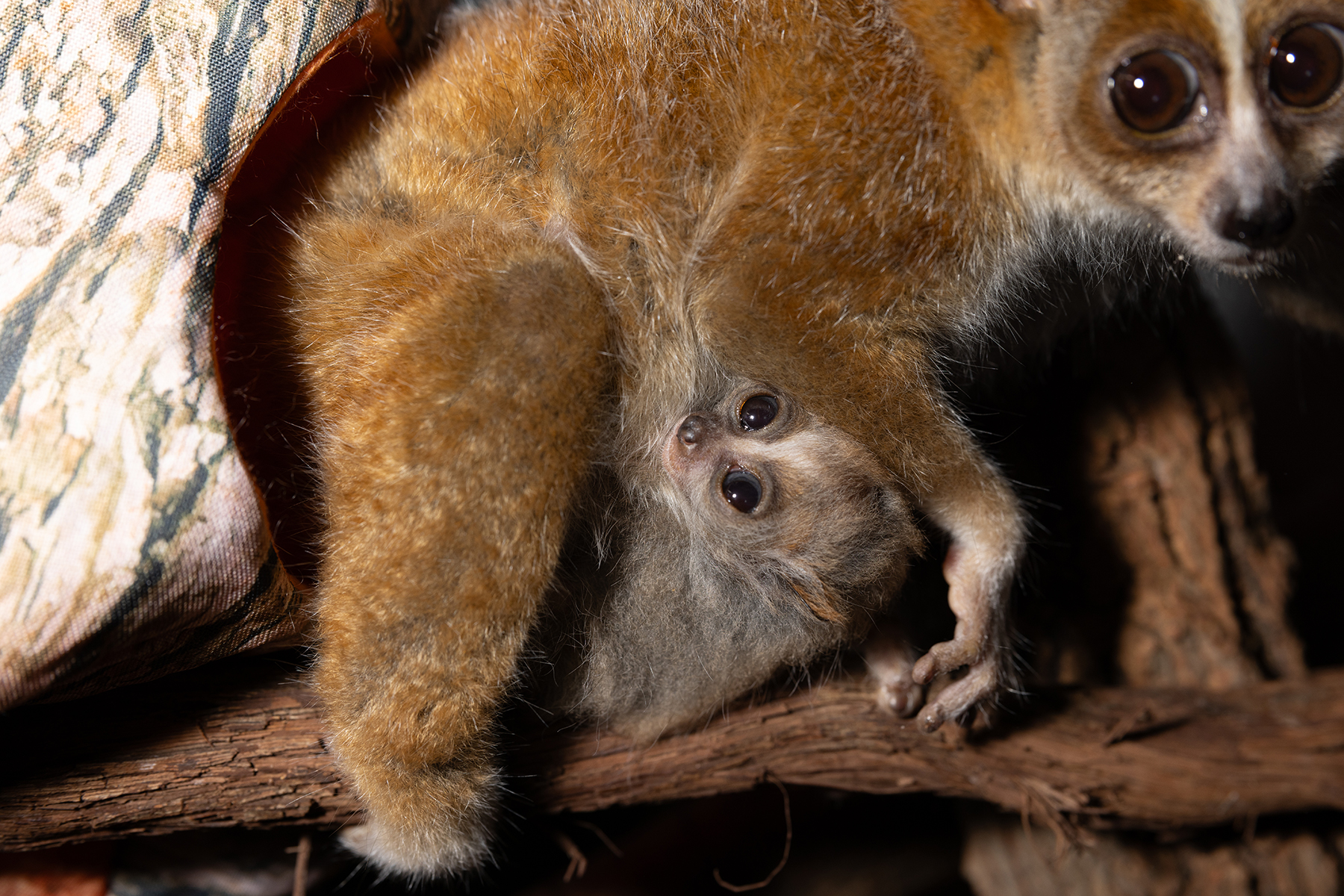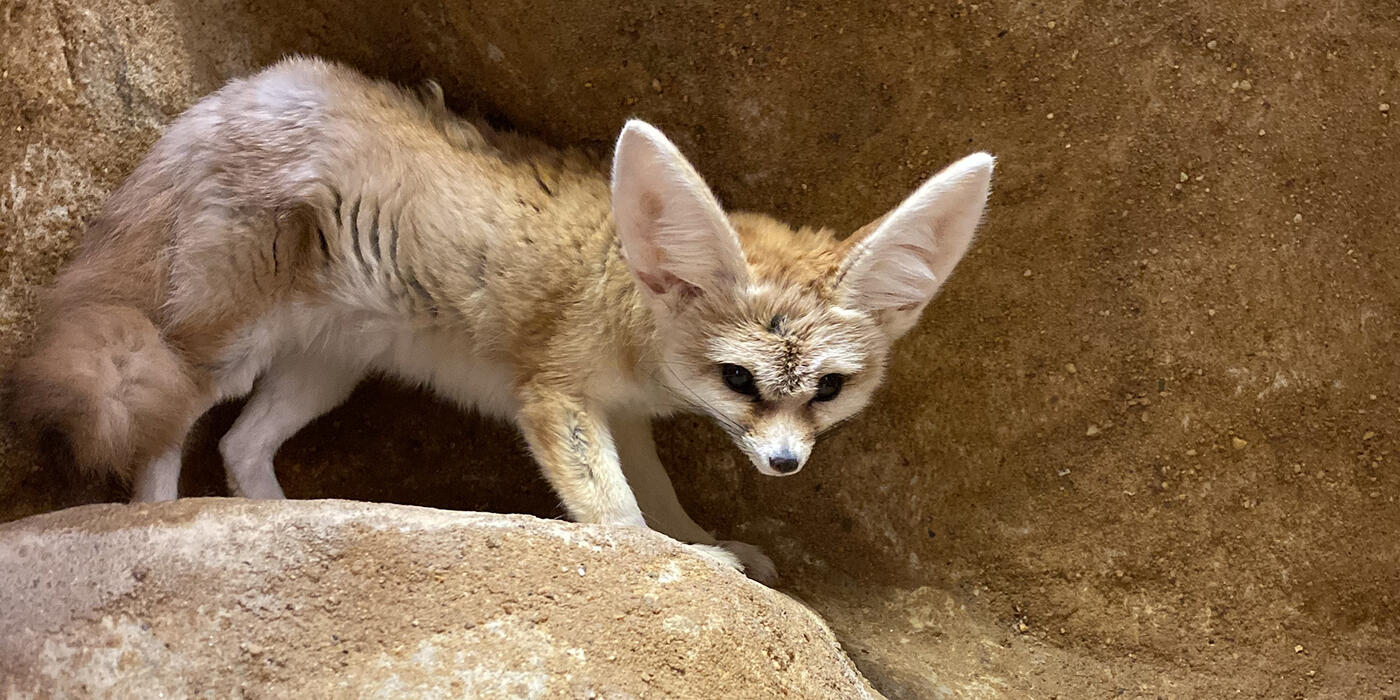Meet Our Pygmy Slow Loris Babies

In March, the Small Mammal House team celebrated the birth of two pygmy slow lorises—a first for the Zoo! Now, the bright-eyed babies are getting braver and exploring their exhibit. See them sample some snacks and hear the latest happenings from keeper Ann Gutowski.

The pygmy slow loris babies are pictured here, a couple days after birth.
What’s new with the pygmy slow loris babies?
They have been growing up so fast! In the past month, we’ve watched them go from taking wobbly, tentative steps to confident strides. Now, they’re traversing the branches like pros and exploring their habitat without Naga (mom) and Pabu’s (dad) supervision.
The babies are getting braver by the day. That includes taking the food we offer them from tongs—if they’re fast enough to grab it before mom and dad swoop in and snatch it, that is!
The babies sample some waxworms...if dad Pabu doesn't get to them first!
Are they still nursing? What foods have they tried?
Most pygmy slow loris babies will be fully weaned by the time they are 3 months old. Ours are likely still nursing from Naga, but we have not observed this behavior for some time. The whole family group sleeps together in one big huddle in their tunnel bed, so we expect they are nursing in there. When they were smaller, we could see them nurse while Naga carried them on her stomach.
Along with waxworms, fruits and veggies, we have seen the babies chow down on primate gel (a soft, nutrient-rich biscuit). Their favorite is gum arabic—a thick, sticky tree sap that makes up 50 to 70 percent of what this species eats in the wild. Their specialized bottom teeth gouge into the bark of trees and cause sap to flow freely. They visit their gouge sites nightly to consume sap. We put the gum inside hanging branches that have holes drilled into them. The whole family descends upon these feeders to lick up the gum—like a big family dinner!

Pygmy slow loris moms, like Naga here, carry around their babies on their stomachs for the first few months of life.
How are Naga and Pabu adjusting to parenthood?
Pygmy slow loris mothers are the primary caregivers of their offspring. Naga is a first time mom. Initially, she seemed a bit confused but eventually settled into her new role. It took her some time to figure out how to carry the babies and decide where to put them down for the night. Over time, she became much more confident and is displaying all the natural behaviors we expect to see. Naga responds to the babies when they vocalize and will put them down and “park” them in a spot while she goes off to explore and eat.
Up until recently, she had been walking around with them riding on her stomach. Now, they are too large for her to carry. The babies have learned to move around on their own, so she is now free to leave and let them explore.
In the wild and in zoos, fathers occasionally interact with offspring, depending on their personality and past experience with babies. Pabu has proved to be an attentive and patient father. He has even carried the babies a few times. We often found him sitting with the babies. He seems very interested in them, but is not above stealing a snack from them.

Keepers tell the babies apart by their sizes and head shapes.
How do you tell the babies apart?
One is larger than the other, and has a rounder face. At two days old, the larger baby weighed about 23 grams (about the size of a AA battery) and the smaller baby weighed 15 grams (about 3 nickels). As of May 21, the larger baby weighed 129 grams, and the smaller baby weighed 105 grams—over five times heavier since they were born! For comparison, mom weighs 506 grams, and dad weighs 496 grams.
The smaller baby took longer to start walking. Now, it seems to be a bit more bold than its sibling. It was the first to eat a waxworm from the tongs, while the bigger one took longer to pluck up the courage.

When it's time to go to sleep, our loris family snuggles all together in this hammock hideaway.
Do you know their sexes?
Not yet! We obtained some samples of the babies saliva using a cheek swab and sent them up to our scientists in the Center for Conservation Genomics for genetic testing. We hope to learn whether we have males, females or one of each soon!

The baby lorises' once wobbly steps are now more confident, says keeper Ann Gutowski.
What makes slow lorises unique among primates?
Slow lorises are the only known venomous primates. They produce a venom in their brachial glands in their upper arm. Combined with enzymes in their saliva, these primates can produce a painful bite, allergic reaction and a slow-healing wound. Wild slow lorises do not use it against predators because the venom is not fast-acting. Instead, the venom is used in territorial disputes with other slow lorises. They also groom themselves with the venom to ward off parasites and warn predators to stay away.

In the late morning and early afternoon, our pygmy slow loris family is usually active and feasting on their favorite food: tree sap!
Got any tips for spotting them?
Because they are nocturnal (animals that sleep during the day and are awake at night), their exhibit area is under red lights to simulate nighttime. Visitors may need to let their eyes adjust to the darkness.
Usually, the lorises are out of their bed and looking for food in the late morning and early afternoon. Some of their favorite hangout spots include the flat branches and the tops of boxes, where they like to sit. Or, look for the hanging branches—they’re often eating there!
Stop by the Small Mammal House to see Naga, Pabu and their babies on your next visit! For the best chance to see pygmy slow lorises up close, attend daily keeper talks at 10:30 a.m. and 2 p.m. Animals are featured at random. Plan your visit today!
Related Species:


